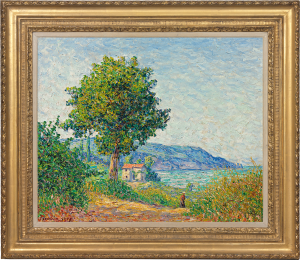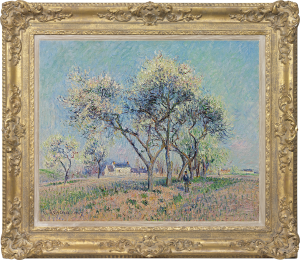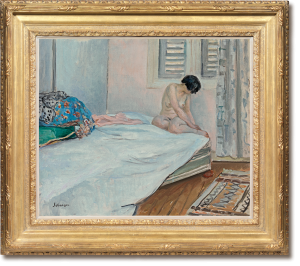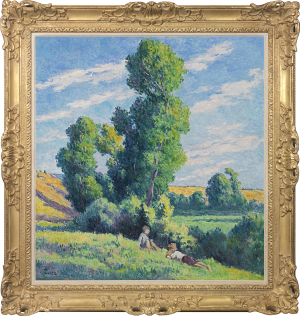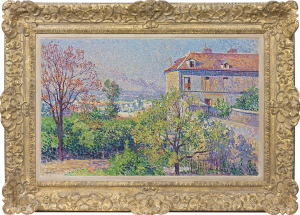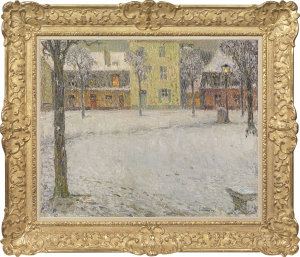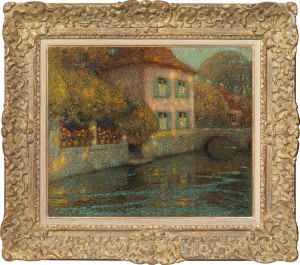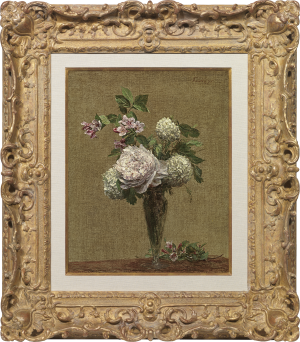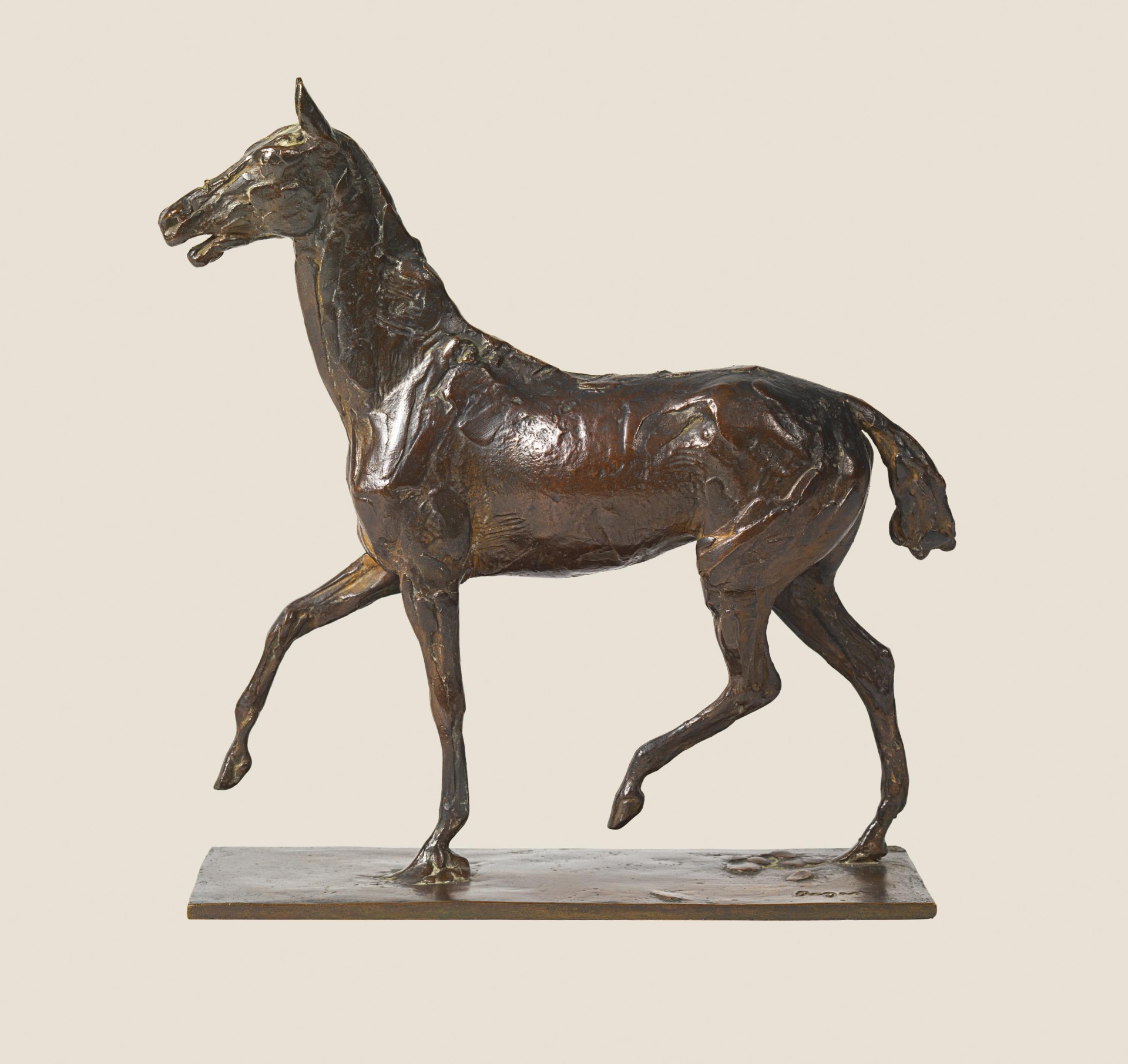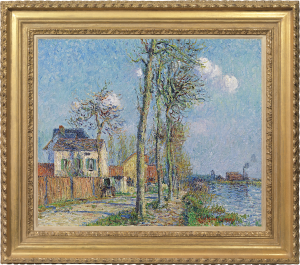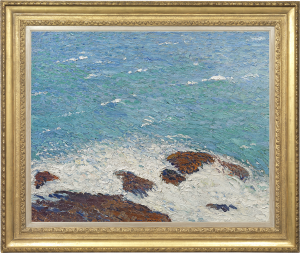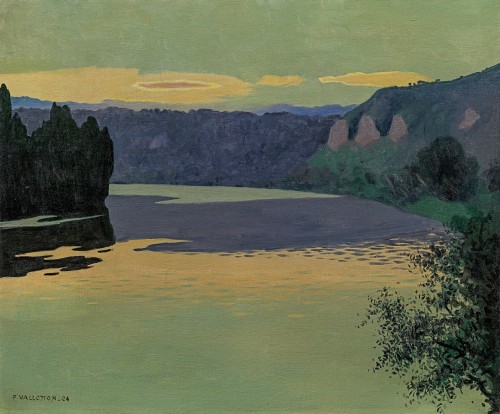
Click on image to enlarge
Felix Vallotton
La Seine aux Andelys, le soir
Oil on canvas: 21.4 x 25.6 (in) / 54.3 x 65.1 (cm)
Stamped with the signature and dated lower left: F. VALLOTTON. 24
This artwork is for sale.
Please contact us on: +44 (0)20 7493 3939.
Email us
FELIX VALLOTTON
Lausanne 1865 – 1925 Neuilly-sur-Seine
Ref: CC 131
La Seine aux Andelys, le soir
Stamped with the signature and dated lower left:
F. VALLOTTON. 24
Oil on canvas: 21 3/8 x 25 5/8 in / 54.3 x 65.1 cm
Frame size: 28 x 32 ½ in / 71.1 x 82.6 cm
In a Scandinavian style carved and gilded frame
Provenance:
The Estate of Félix Vallotton;
his stepson Joseph-Jacques Rodrigues-Henriques (1886-1968), Paris
Dr Roux Berger, Paris, by 1932
Private collection, Paris
Literature:
Félix Vallotton, MS ‘Livre de Raison’, LRZ 1499, ‘La Seine aux Andelys, le soir, soleil couché, des reflets jaunes traînent sur l’eau (T 15)[1]’
Marina Ducrey with the collaboration of Katia Poletti, Félix Vallotton 1865-1925 L’Oeuvre Paint III: Catalogue Raisonné Seconde Partie 1910-1925 (CR 748 à 1704), Zurich/Lausanne 2005, vol. III, pp.831, no.1596, illus.; 308
A Swiss Protestant who spent most of his career in Paris; a Nabi who painted with the chill precision of his Northern forebears; an individualist who eschewed all the ‘isms’ of the twentieth century: Félix Vallotton has been called the ‘Painter of Disquiet’[2]. He turned a merciless eye on bourgeois manners in his prints of the 1890s; a dispassionate gaze on the human body in his series of female nudes; drew out the vulnerabilities of his sitters (including himself) in his portraits.
Vallotton also painted landscapes most of his career, but particularly in his later years, after 1909. Marriage in 1899 to a wealthy widow, Gabrielle Rodrigues-Henriques of the Bernheim-Jeune art dealing dynasty, ensured his material comfort and allowed him to pursue whatever genre inspired him. La Seine aux Andelys, le soir, painted in 1924, is a paysage composé, ‘a selective synthesis based on memory’[3], or, as the novelist and critic Julian Barnes puts it in his brilliant essay ‘Vallotton: the foreign Nabi’: ‘He would go out into the countryside, make sketches and notes, then return to his studio and assemble the picture using material from different sites: a new, technically non-existing nature, created for the first time on canvas’[4].
This painting depicts the Seine at Les Andelys in Normandy, south-east of Rouen. The valley, cut deeply by the meanders of the river, has high white cliffs on one side and lush flood plain on the opposite banks. The ancient town, with its half-timbered houses, has a thirteenth century church. The heights are dominated by Château Gaillard, built in the late twelfth century by the English Plantagenet King Richard the Lionheart to defend his Norman lands. Vallotton made several expeditions to this magical spot, its history enhanced by the fact that it was the birthplace of his hero, the painter Nicolas Poussin (1594-1665). Poussin’s development of ‘historical landscape’, which metamorphosed the changeable elements of nature into compositions of grandeur and permanence, was deeply influential upon his own practice. Vallotton defined this in his Journal after an exhilarating stay at Les Andelys in 1916: ‘I dream of painting free from any literal respect for nature, I would like to reconstruct landscapes solely with the help of the emotion they gave me, a few broad, evocative lines, one or more details, chosen, without slavish devotion to the accuracy of time or lighting. Basically, it would be a sort of return to the famous “historical landscape”. Why not?’[5].
La Seine aux Andelys, le soir abstracts the essence of a sunset as the colour leaches from the landscape and the purple shadows gather. The scene is taken from just beyond the town of Les Andelys, looking north-westwards, with the dark mass of the Ile du Château on the left. Vallotton is less interested in topographical detail, however, than in the shapes which the austere masses of land make on the canvas. A finger of shadow cuts across the Seine, throwing the reflection of the last band of pale apricot sunset into relief. This band is echoed in the sky, where the departing day irradiates a slender skein of cloud. The bald, pale faces of the limestone cliffs on the right glimmer in the twilight. Vallotton evokes a landscape which is gently melancholy, dreamlike and mesmerizing, painted in a spirit very far from the exuberance of Impressionism, but proudly powerful and individual.
FELIX VALLOTTON
Lausanne 1865 – 1925 Neuilly-sur-Seine
Félix Vallotton was born in 1865 in Lausanne to a Protestant family of French origin; his father kept a hardware store. In 1882 he went to Paris and for three years studied at the Académie Julian with Jules Lefebvre, Gustave Boulanger and the painter and engraver Charles Maurin, who encouraged his skill as a printmaker. Vallotton’s early work, culminating in La malade, 1892 (Kunsthaus, Zurich), shows an exquisite realism, cool northern light and the influence of Dutch seventeenth century masters. His frequent model in these years was his companion Hélene Chatenay.
From 1891 Vallotton began to make black and white woodcut prints. Their economy of line and acute eye for satire on urban life made him a favourite with avant-garde, left-wing magazines such as the Revue Blanche, edited by Thadée Natanson. Vallotton was drawn into the intellectual circle round the Revue and was invited by the Nabis (Prophets), a group of artists including Pierre Bonnard, Edouard Vuillard and Maurice Denis, to become one of their number. Realism gave way to works such as Bathing on a summer evening, 1892-93 (Kunsthaus, Zurich), where a synthetic, decorative style evokes inner feelings. Vallotton’s print series Intimacies (1897-98) chillingly skewers the hypocrisies and ambiguities of bourgeois marriage, thoroughly in tune with the age of Freud and Ibsen.
In 1899 Vallotton made his own bourgeois marriage, to a wealthy widow, Gabrielle Rodrigues-Henriques, the daughter of the influential art dealer Alexandre Bernheim-Jeune. His financial and professional comfort was assured. Vallotton’s brother Paul ran a branch of Bernheim-Jeune in Lausanne, marketing his work to Swiss collectors such as Hedy Hahnloser. Paintings such as Intérieur avec femme en rouge de dos, 1903 (Kunsthaus, Zurich), depict richer settings but retain the disquietude of his earlier work. Domestic bliss eluded Vallotton and his relationship with his stepsons was distant. His style in this period is a painterly but austere naturalism, seen for example in his portrait of Gabrielle Vallotton, 1905 (Musée des Beaux-Arts, Bordeaux). He painted many nudes in this period, sometimes in mythological guise, as in L’enlèvement d’Europe, 1908 (Kunstmuseum Bern), sometimes with the cold gaze of La blanche et la noir, 1913 (Kunstmuseum Bern).
Vallotton became a French citizen in 1900. Too old to fight in the First World War, he expressed his patriotism in his This Is War! woodcuts (1916). In June 1917 he received a government commission to record the effects of war in the Champagne region. Verdun, 1917 (Musée de l’Armée, Paris) is a powerful, near-abstract painting of burning forests and strobing lights, a French counterpart to the war compositions of the English artist Paul Nash. Vallotton referenced the war even in his pristine still lifes: the red peppers and knife in Poivrons rouges, 1915 (Kunstmuseum Solothurn) are painted as if slicked in blood.
Vallotton’s landscape painting refines a motif in nature so that the scene takes on a hallucinatory quality. With these ‘paysages composés’ he made a single sketch from nature and used it as a point of departure for a painting created in the studio, where he could achieve the formal design, hard light and eerie stillness which he sought. Although he painted landscapes before the First World War, in the 1920s nature provided Vallotton with the solace of escape from a shattered world. He died in Neuilly-sur-Seine in 1925.
The work of Félix Vallotton is represented in the Kunsthaus, Zurich; the Kunstmuseum Bern; th Fondation Félix Vallotton, Lausanne; the Musée de l’Armée, Paris; the Musée d’Orsay, Paris; the Art Institute of Chicago and the Metropolitan Museum of Art, New York.
[1] T 15 indicates a canvas 65 x 54 cm (Vallotton puts width before height). See Ducrey, op. cit., vol. I, p.267.
[2] See the excellent exhibition at the Royal Academy, London and the Metropolitan Museum of Art, New York, Félix Vallotton: Painter of Disquiet, 2019-2020.
[3] ‘Une synthèse selective fondée sur la mémoire’: Ducrey, ibid., vol. I, p.177.
[4] Keeping an Eye Open: Essays on Art, London 2015, p.189.
[5] ‘Je rêve d’une peinture dégagée de tout respect littéral de la nature, je voudrais reconstituer des paysages sur le seul secours de l’émotion qu’ils m’ont cause, quelques grandes lignes évocatrices, un ou deux details, choisis, sans superstition d’exactitude d’heure ou d’éclairage. Au fond ce serait une sorte de retour au fameux “paysage historique” Pourqoi pas?’. Quoted in Ducrey, ibid., vol. I, p.178.



